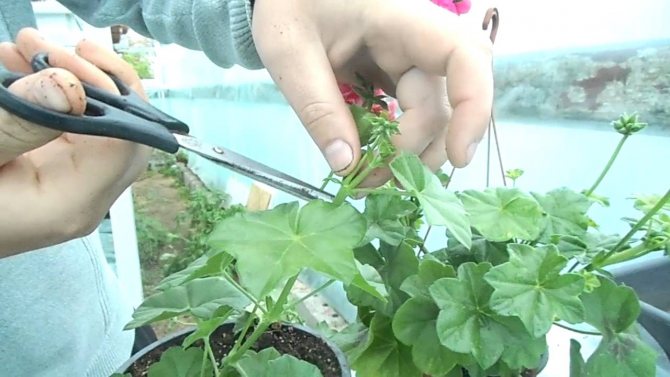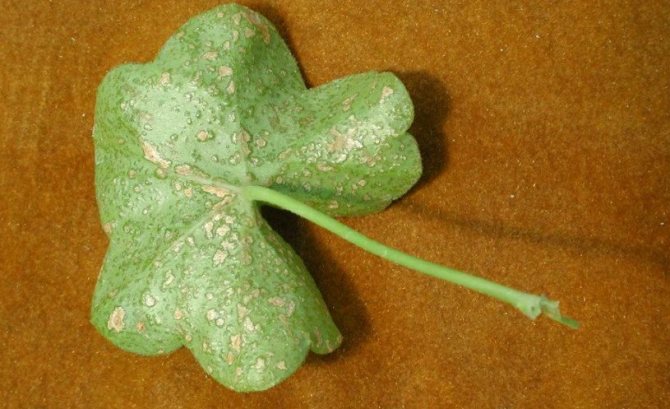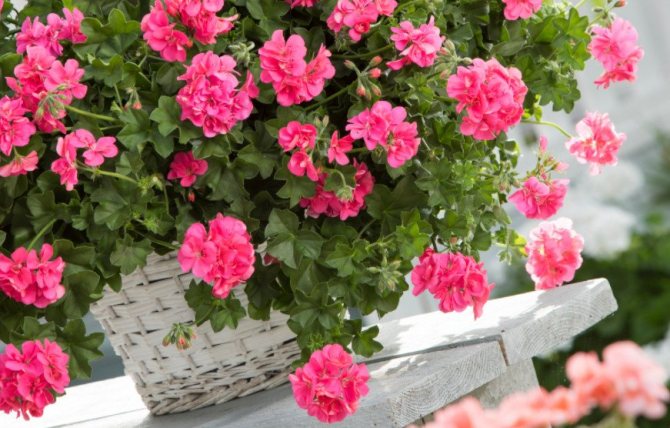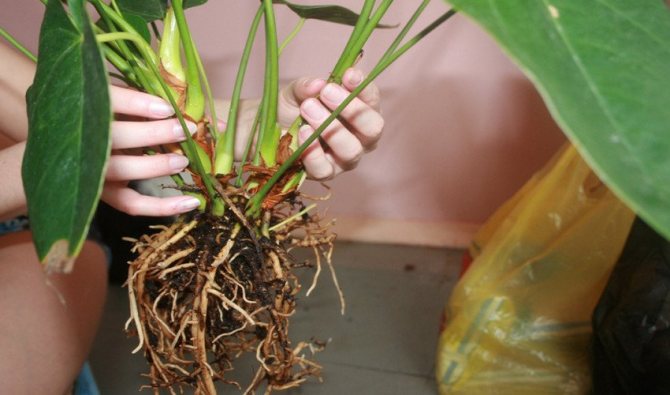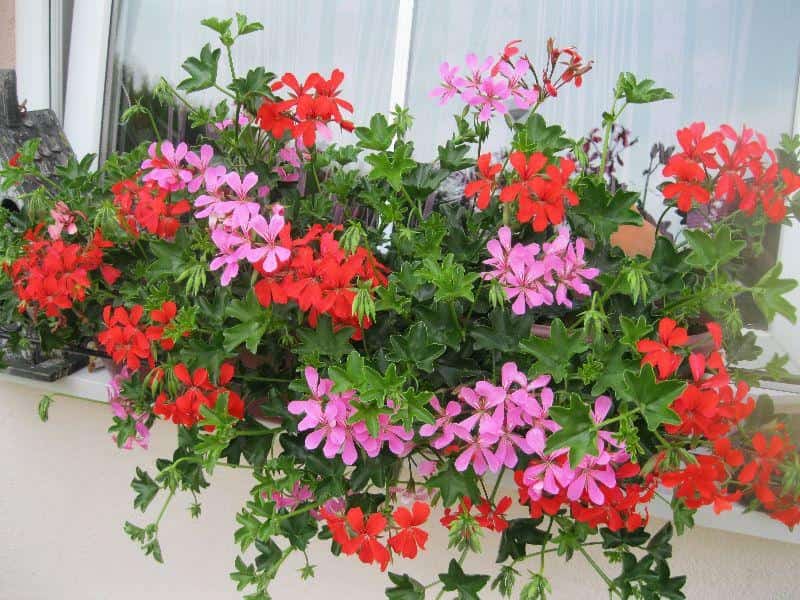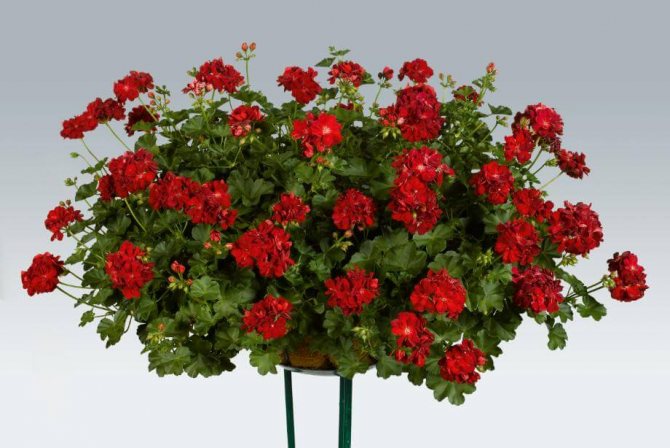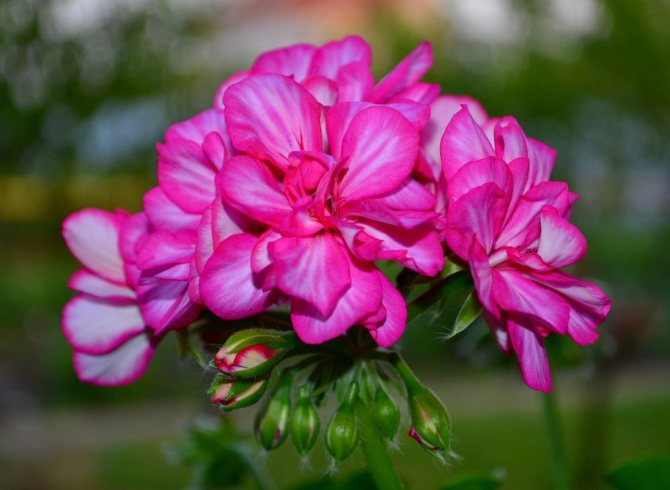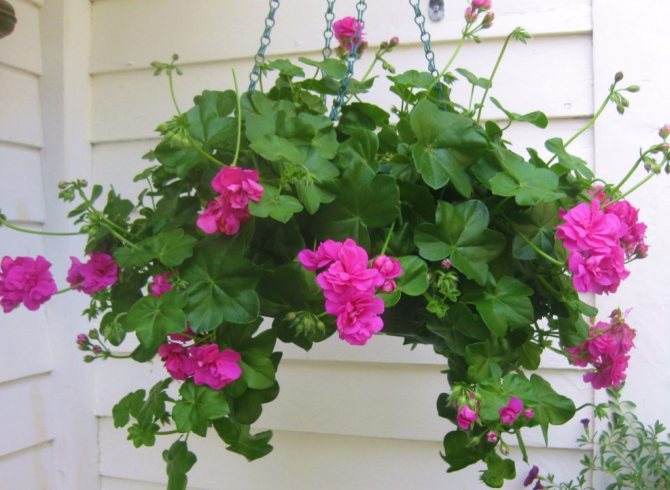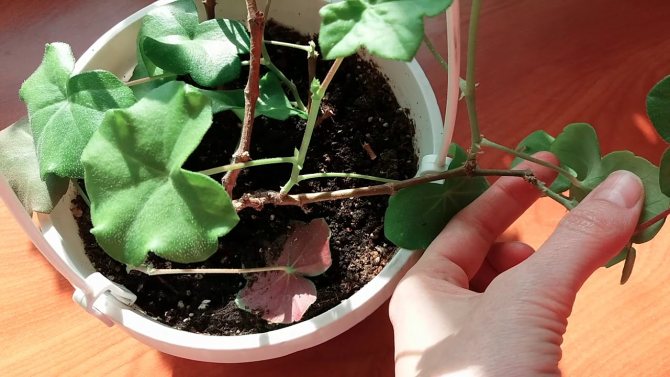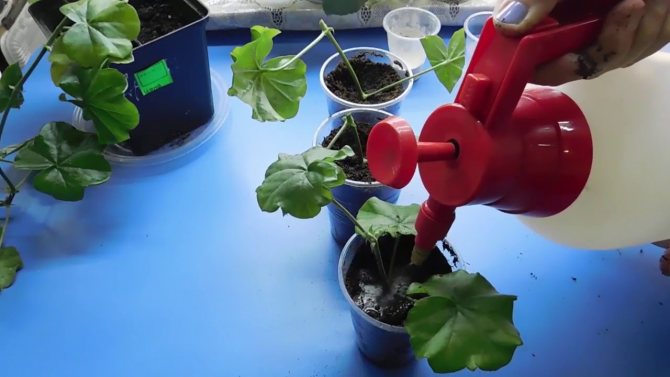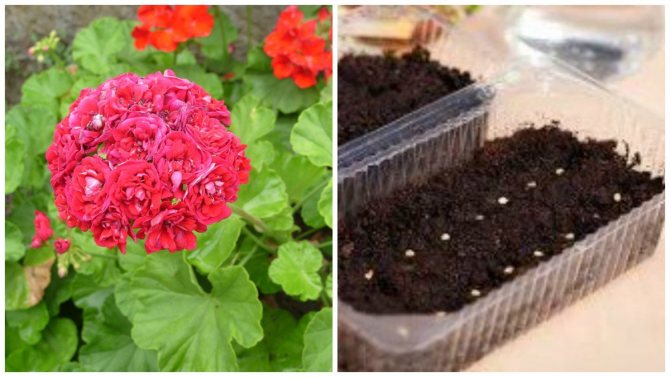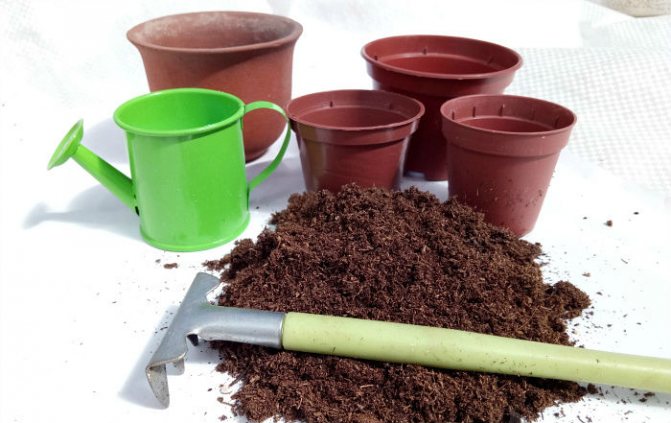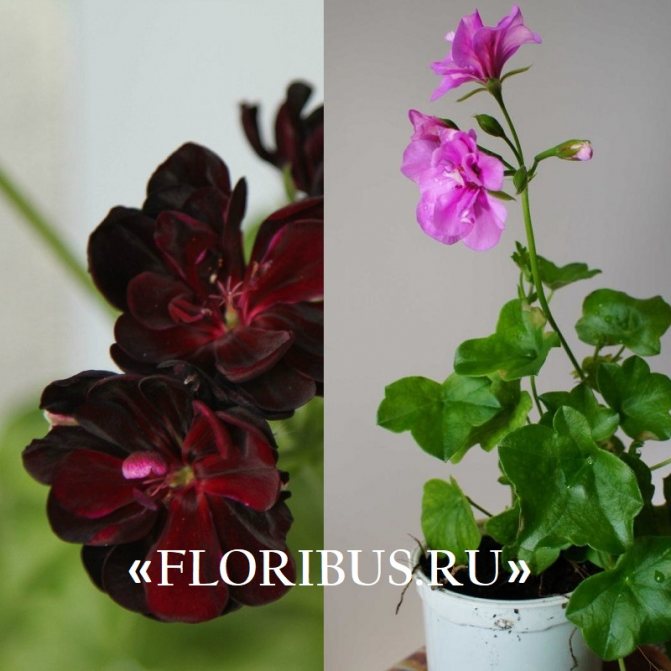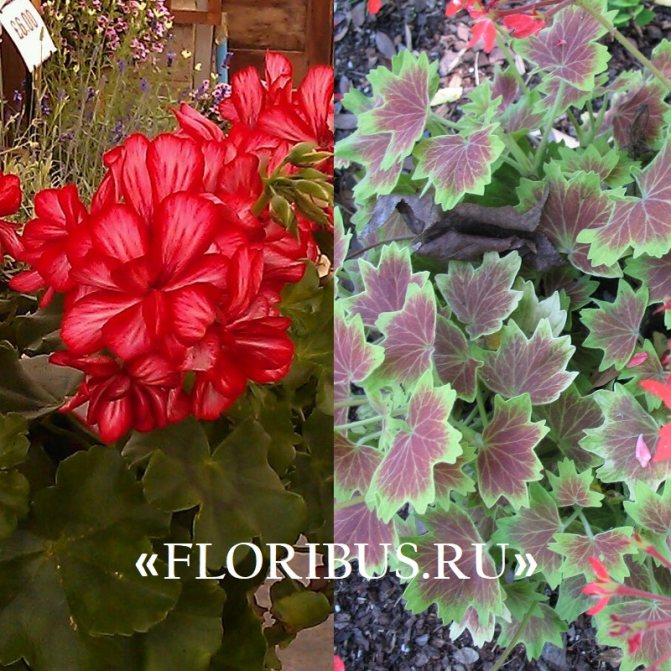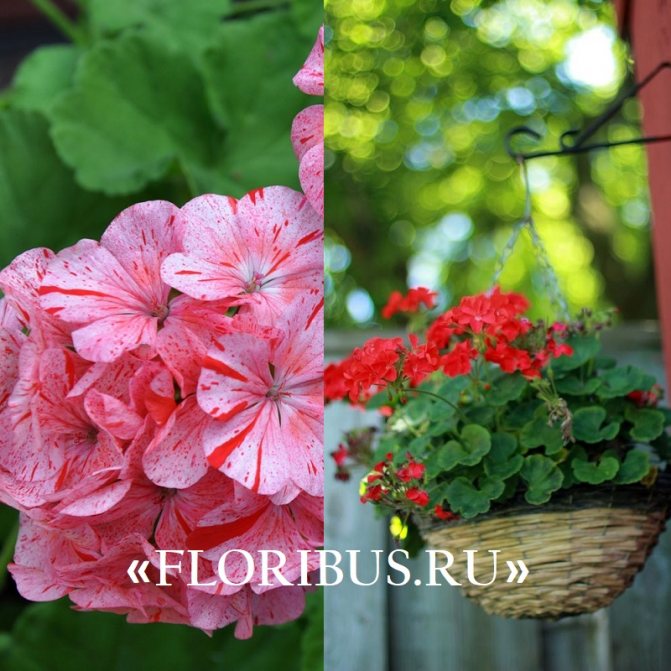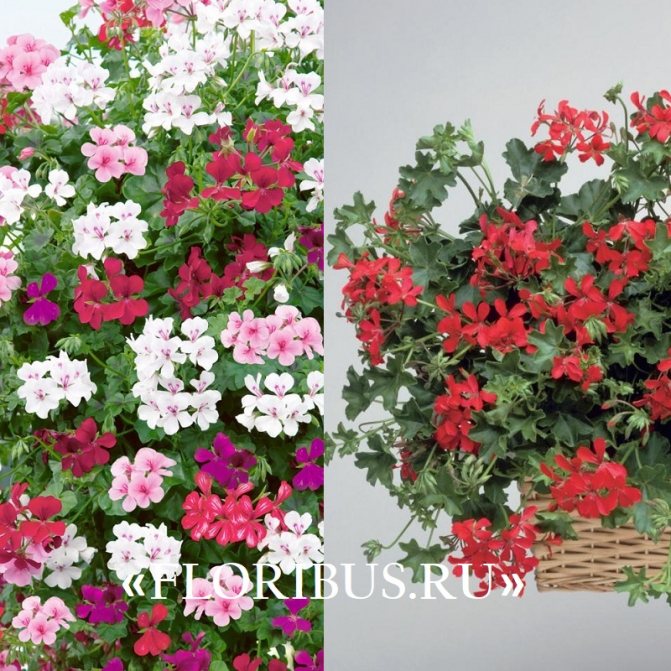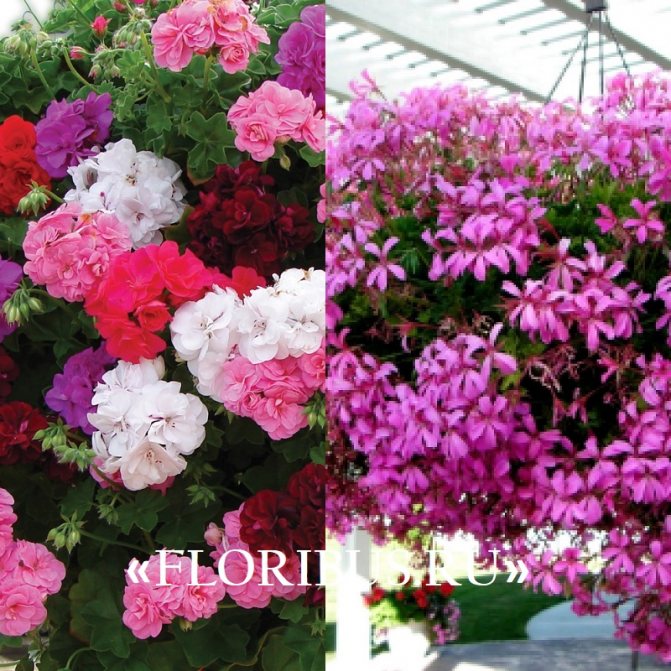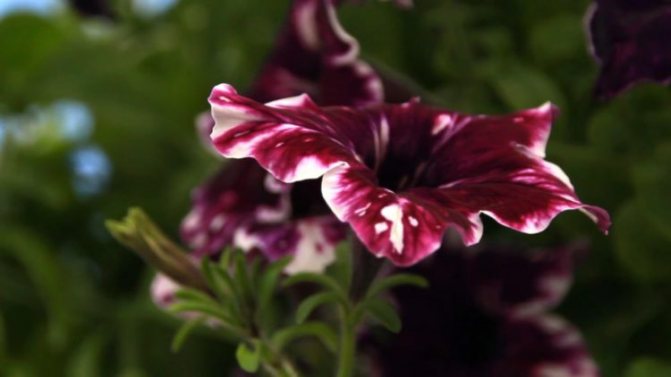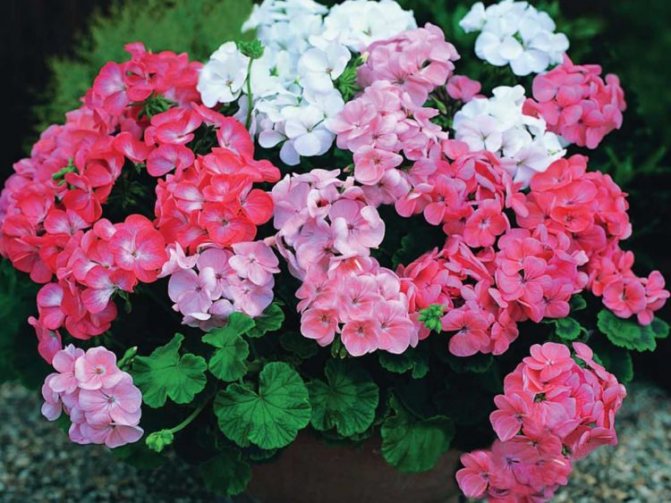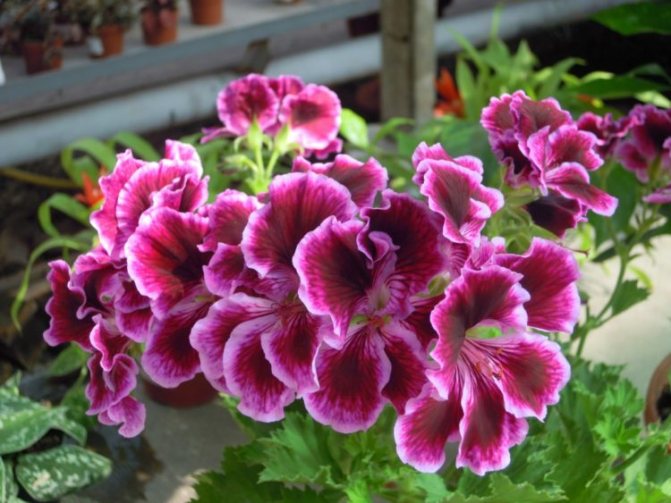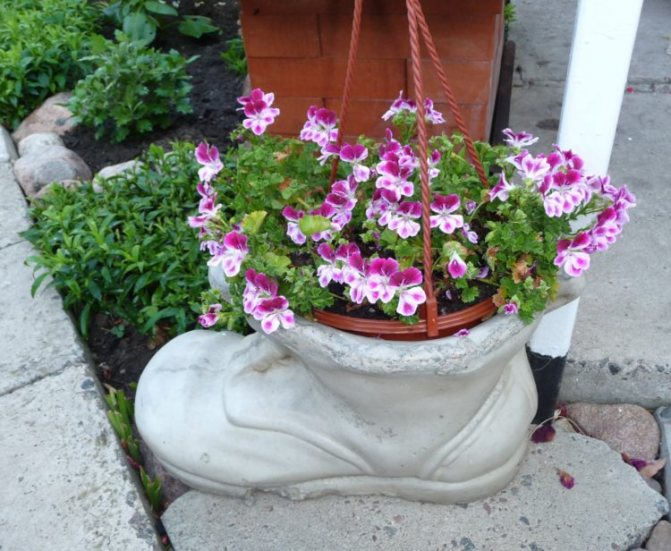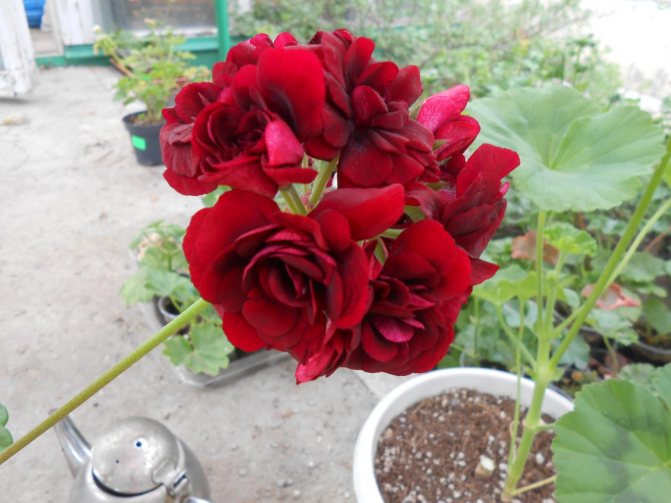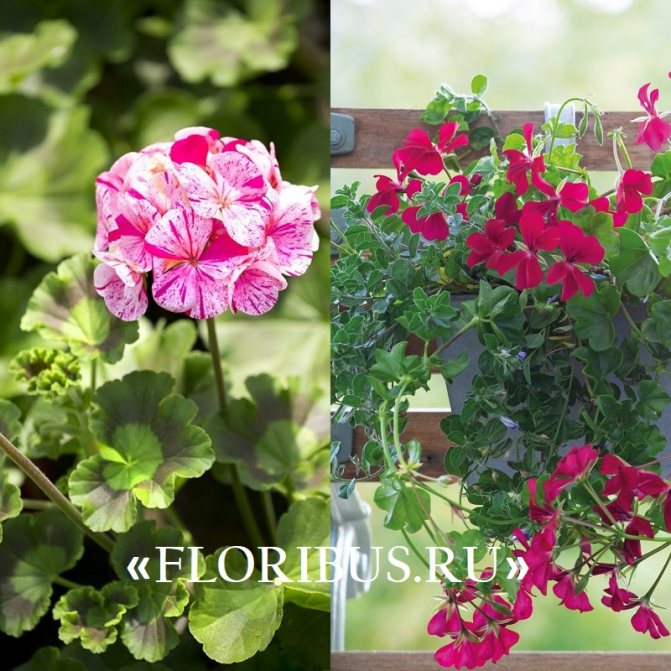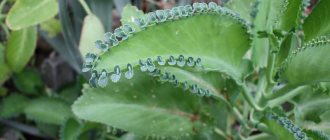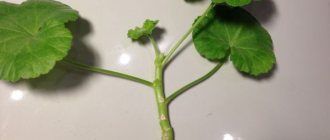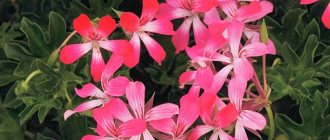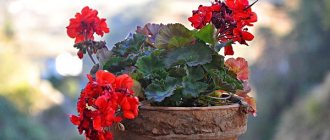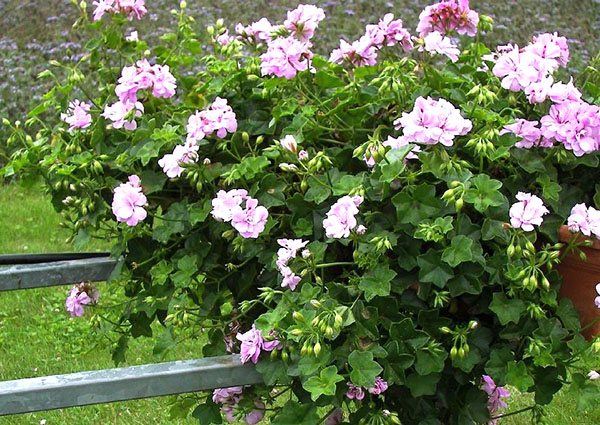
Pelargoniums or indoor geraniums are loved all over the world for their docile, capricious disposition and brightness of flowering. But along with the common bush forms, ampelous geraniums - or thyroid or ivy-leaved pelargonium - are increasingly used for vertical gardening, decorating flowerpots and hanging pots.
The Pelargonium peltatum species stands out not only for its ability to form graceful, but quite strong flowing shoots up to a meter long. A characteristic feature of this variety of indoor geranium is dense five-toed leaves of an even green or variegated color. See also the photo of the oleander flower!


In the axils of the leaves on the tops of the stems, tall peduncles are formed, bearing lush umbellate inflorescences. Flowers can be of different shapes, from simple star-shaped to double or pink-shaped, and very different colors. At the disposal of florists there are varieties with monochromatic and two-color corollas with a diameter of 1.5 to 4 cm.
Conditions for growing ampelous geranium at home
Ampel forms of ivy geranium feel good in lighted places, where the plants are not threatened by drafts or cold gusts of wind. If in the summer it is supposed to take out pelargonium in the open air, in the spring it is better to harden the plants, gradually accustoming them to outdoor content and increasingly taking them to the balcony or terrace.
Hardened specimens can withstand a significant drop in temperature. But if the thermometer drops below zero, damage to the tops of the shoots or more serious harm cannot be avoided.
Since ampelous geraniums in nature are plants of mountainous regions, they are most often undemanding to the composition of the soil. Better if:
- pets are planted in a fertile substrate with the addition of a small amount of clay;
- a powerful drainage layer is made at the bottom of the pot.
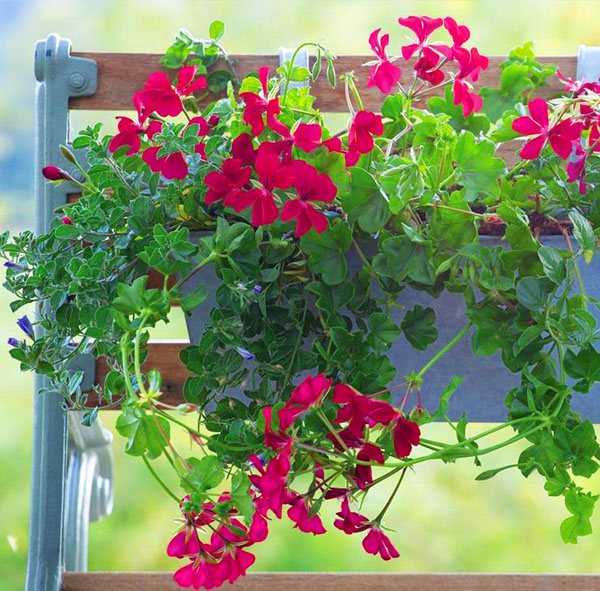

When caring for ampel geraniums, the culture is provided with regular, but moderate watering. Excessive moistening of the soil under the lush falling crown of the plant threatens to disrupt the aeration of the soil, rotting roots and the death of pelargonium.
Summer care for ampelous geraniums at home
During the period of active growth, which lasts from March to the end of August, the ampelous variety of indoor geranium needs regular feeding.
With constant care, ampelous geranium at home reacts well to weekly application of complex fertilizer.
How to feed geraniums so that it blooms for a long time and abundantly throughout the season? If in the spring of pelargonium for better growth it is possible to give funds containing a significant amount of nitrogen, it is better to limit geranium in this element from the second or third feeding. Otherwise, the florist will admire the large dense leaves all season, but the flowering will be either very weak, or the buds will not appear at all.
As they grow, when the roots completely settle down the volume of the pot allotted to them, the plants are transplanted.
Ampel geranium at any age tolerates this procedure without loss, the main thing is not to choose the next container much larger than the previous container. Until the roots unfold to its full extent, pelargonium will not honor the owner with bright caps of flowers.
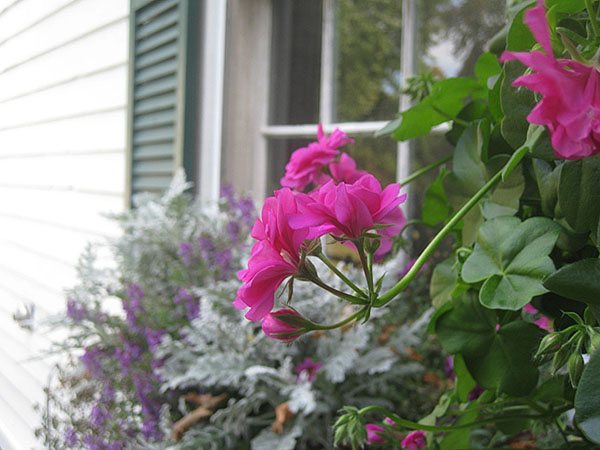

In the warm season, caring for ampelous geraniums consists of:
- from irrigation carried out when the upper layer of the substrate dries out;
- from dressings, combined with moistening the soil under the plant;
- from the obligatory pruning and pinching of shoots.
How to pinch geraniums so that the middle of the crown does not expose the plant, and the lower shoots form beautiful cascades? In bush species, in spring and especially in autumn, a fairly deep crown pruning is performed. This allows you to give the bush a compact shape and achieve lush flowering in the coming season.
The attractiveness of the ampelous geranium is not only in the inflorescences, but also in the long shoots "flowing" downward. Therefore, only the already bare or drying stems are pruned, and the rest try to pinch gently.
This technique causes:
- branching due to the awakening of dormant buds;
- the formation of more inflorescences on new stems.
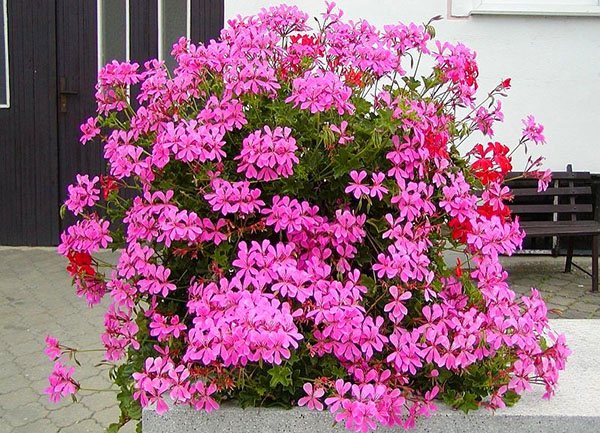

As a result, the top of the crown does not "go bald", and the flowering spreads to the whole plant, turning into a bright colored ball.
When and what to feed ampel geranium
After pruning, the plant should be fed with mineral and organic fertilizers. The choice of nutrient mixture depends on the wishes of the grower, since different stimulants can individually affect the plant. For example, nitrogen supplements are a stimulant for green mass and shoot growth. An overdose of nitrogen, meanwhile, is fraught with yellowing of the foliage and a small number of buds.
Potassium and phosphorus are contained in large quantities in the "Diet" preparation. Magnesium sulfate is also an excellent help for pelargonium. After such feeding, numerous inflorescences are formed on the plant, which leads to a magnificent and long flowering.
Fertilizers must be applied every 10 days throughout the season, starting in spring, only before "wintering" they stop giving to the plant, so that stimulants do not affect a safe rest in the cool.
Caring for ampelous geraniums in the winter
For wintering ampel geraniums, you need:
- a cool place where the temperature is between 5-12 ° C;
- diffused, but rather bright lighting;
- rare watering that does not affect foliage and shoots.
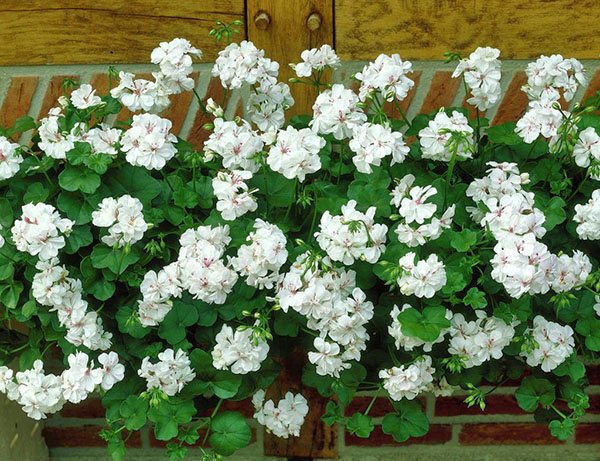

If the plants lack light, by the spring a mass of weak, stems with crushed pale leaves will form on them. And excess moisture when caring for ampel geraniums in winter is a sure reason for decay of the root collar and peripheral roots.
In addition to observing the temperature and humidity conditions, providing light, ivy-leaved pelargoniums need to remove old foliage. It is better to do this with scissors so as not to damage the buds in the leaf axils.
Pruning and shaping the bush
Pelargonium pruning is needed not only to give the bush the desired shape, but also to rejuvenate the plant, stimulate its growth and flowering in the next season.
All about pruning and pinching pelargonium
Pruning is done during a quiet period when the geranium is not going to bloom. Bad leaves and weak branches, the longest shoots are cut off. It turns out a beautiful, low bush.
Note! If the flower is properly cared for, it will grow again. Re-pruning, if necessary, is carried out in early spring.
A pinch is needed to stimulate lush flowering, to awaken dormant buds. The essence of the procedure is to remove the buds with fingers or scissors, which are located at the very top of the bush and at the tips of the shoots.
The procedure slows down flowering, therefore it must be stopped as soon as the flower takes on the desired shape.
Growing geraniums from seeds
You can propagate the ampelous geranium of the variety you like using seeds or vegetatively, by cuttings. The first method will require a lot of labor, but it is irreplaceable when it comes to obtaining new hybrids or the lack of the desired cuttings.
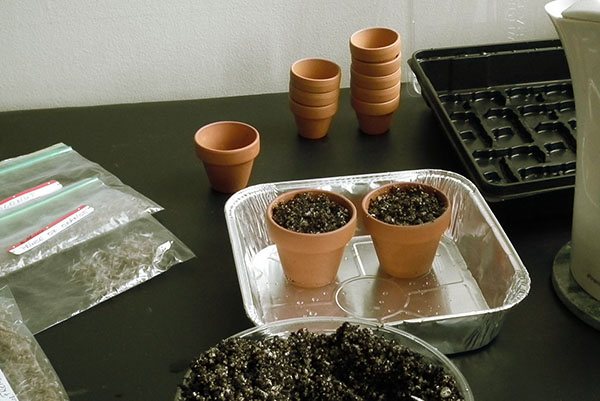

Growing geraniums from seeds can be carried out from December to the last days of April. True, in winter, you cannot do without the use of specialized illumination of seedlings:
- Seeds 3-5 mm are embedded in a mixture of peat, sand, garden soil and sphagnum.
- A container with a moist substrate is placed in a mini-greenhouse or under a film, where a constant temperature, air and soil humidity are maintained.
- With good lighting and a temperature of 22-24 ° C, seeds sprout in 7-10 days.
- After 3 weeks, the grown plants are picked.
Propagation of ampelous geranium by cuttings


You can get healthy, fully transmitting the characteristics of the mother plants ampelous geraniums using cuttings. They are cut from mature bushes at the end of summer, when the mass flowering ends and the pruning of pelargonium is carried out. If green pets gave a good, strong growth in winter, then spring cuttings can be easily rooted.
But it is important to remember that, unlike zoned pelargoniums, ivy-leaved varieties do not behave well in water. They easily rot, so it is required to root the cuttings in the soil of peat, sand and a small amount of humus.
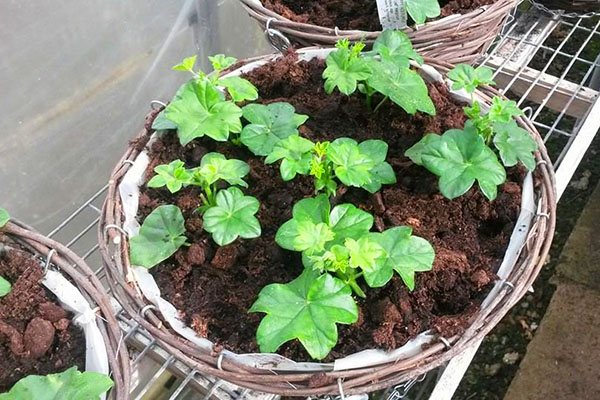

Saplings 7–12 cm long with several own leaves:
- within 2 - 6 hours air-dried;
- treated with crushed charcoal or activated carbon;
- planted at a short distance from each other along the edge of the container or pot.
Young ampel geraniums do not need greenhouse conditions for rooting. They develop their own roots about three weeks after being cut from the mother bush.
After the formation of several leaves, a pinching is carried out, stimulating branching. With good care, ampelous geranium blooms at home after the first wintering and then for many years pleases the owner with a green crown and lush caps of inflorescences.
Video about beautiful ampel geraniums


Geraniums blooming in small home pots are no longer surprising, but this does not apply to the ampelous varieties of this plant.
It is enough just to place the ampelous geranium (pelargonium) in a flowerpot and any home corner will instantly be transformed thanks to its luxurious curly stems.
So, is it difficult to grow this type of geranium at home? How to achieve abundant flowering? And also, about the features of planting and transplanting ivy-leaved pelargonium.
Landing requirements
Geranium ampelous is a culture that develops very intensively, so the soil should be loose and nutritious. It is necessary that it does not retain moisture, otherwise the roots will rot.
The ideal soil option would be a mixture of: garden soil, peat, sand in equal quantities. You can also apply a ready-made soil mixture intended for ornamental plants, add a small amount of vermiculite or sand there.
For abundant flowering, experienced flower growers limit the plant in growth, that is, they plant it in a pot, a little more than the volume of the root system. When the earthen lump is completely covered with roots, the plant is transplanted according to the same principle in a large container. The plant itself begins to warn about the need for transplantation by yellowing foliage.
An adult bush will feel quite well in a pot with a diameter of 10-12 cm. It is better to take a container made of porous ceramics, it allows air to pass through and protects the roots from decay.
Features of pelargonium ivy
Ampel geranium or as it is also called pelargonium ivy - a plant intended for decorating a hanging garden or use as a home decoration in flowerpots, etc. It has very flexible shoots that curl quite strongly and can reach a length of as much as 1.5 m.
The leaves of the ampelous geranium are quite large, with a smooth surface, bright green or variegated white, in diameter reaching from 3 to 6 cm.Peduncles are long, holding umbellate inflorescences, represented by several cactus / star-shaped flowers. Inflorescences are both double and simple, of numerous shades: white, lilac, purple, two-colored and even spotted.
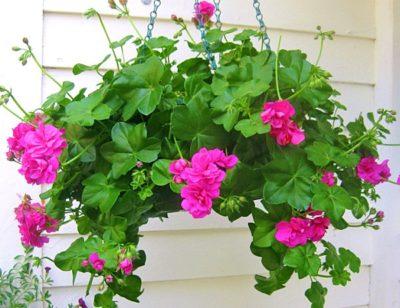

Pelargonium is very fond of sunlight, moreover, it perfectly tolerates exposure to direct sunlight.
Moreover, the plant needs enough fresh air, therefore, when growing at home, you should either often ventilate the room in which the geranium lives, or sometimes take it outside.
As for the temperature regime, in the summer period, it should be provided with optimal conditions: the temperature indicators should not be higher than +25 degrees.
At home, it is quite difficult to achieve this, which means that you will have to move the pot with the plant to the veranda or cold balcony.
Since pelargonium needs a lot of light, it is best to place the pot with the plant in the house on the southern windowsill... In the absence of such, a western window will do.
Below you can see a photo of the ampelous geranium.
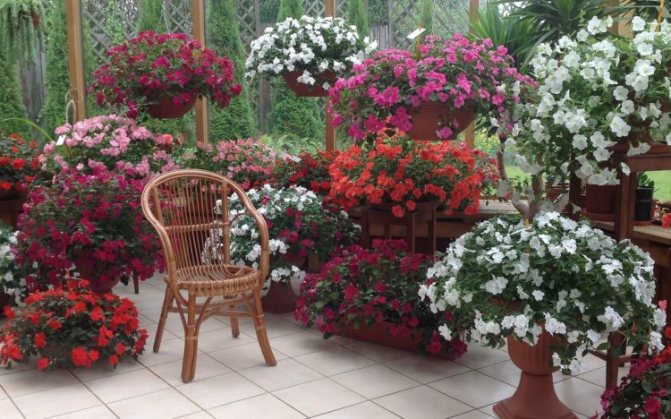

Botanical description of the plant
The main feature of this plant from the Geranium family is hidden in its name - such geranium has flattened leaves, which resemble ivy in structure: the same five-lobed, leathery and smooth. Under natural conditions, such leaves are very strong, capable of wading through rocky soil and even rocks, but at home, pelargonium leaves are most often thin and have a decorative miniature appearance.
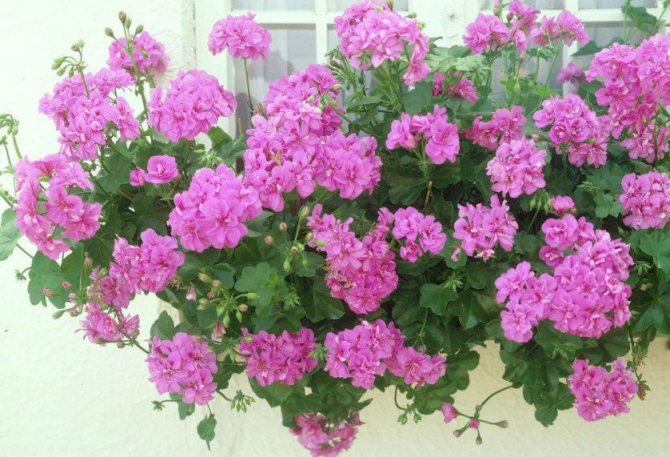

The branches are long, flexible, hanging down, so this geranium is most often planted in hanging pots and pots. This type of geranium with hanging leaves is called ampelous (Ampel - literally means "hanging vase"). Umbellate inflorescences, formed by 5-9 flowers in one bundle. This geranium usually blooms from mid-spring to mid-summer. The shade of such inflorescences has a rich variety: today there is pelargonium, blooming with almost all flowers.
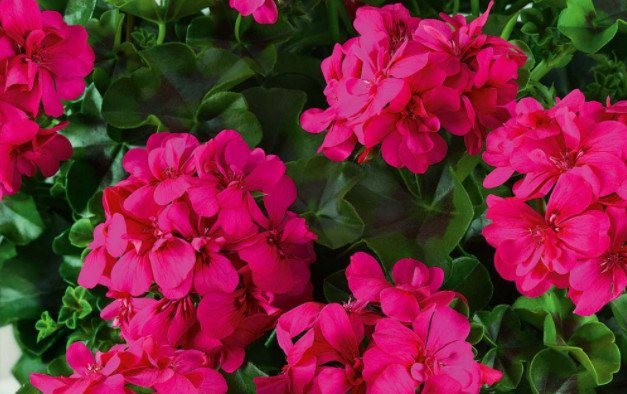

Did you know? The closest relative of pelargonium is geranium: the first specimens of this plant were discovered in South Africa at the end of the 17th century, from where they were brought to Europe. Despite the fact that pelargonium and geranium are often meant as synonymous names, these are two different plants, however, from the same family - Geranium.


The color can be heterogeneous - with contrasting spots, stripes, dots and rims. The size of an adult ampelous pelargonium can reach 1.5 m in length, so pots with such geraniums are most often placed on a balcony or a cascade stand.


Under natural conditions, this geranium is formed in small quantities in temperate and warm latitudes, it is found in Italy, Spain, and also in some regions of China.
Ampel plants are decorative flora with hanging shoots and climbing stems that look great in hanging pots and boxes. These are verbena, lobelia, fuchsia, dichondra, petunia.
The subtleties of planting and transplanting at home
Pelargonium can be planted by seed or cuttings. True, even experienced gardeners prefer exclusively the second option, since it is much simpler and more convenient.
So, when planting with cuttings, the material should be prepared in advance: the cuttings should dry out within 24 hours. After that, they are planted in disinfected soil, observing the distance between individual specimens within 2 cm (it is preferable to dip the cuttings in a cut into coal powder).
You don't have to transplant every year: it is enough to transplant geraniums into a new pot once every 2 years.
When transplanting geraniums, its root system should be located close to the walls of the pot.
How to care for a lush bloom?
In order for the plant to feel comfortable at home, it is necessary to provide it with proper and regular care.
We talked in detail about the rules for the care and cultivation of ampelous or ivy-leaved geraniums here, and from this article you will learn about how to propagate a flower.
How to water and what to feed?
Geranium loves moisture very much, therefore the soil in the flower pot should always be moist, but not excessively, otherwise it will be fraught with mold. To accelerate the process of water passing through the soil, drainage must be selected appropriately. In winter, the frequency of watering should be reduced to 2-3 times a month.
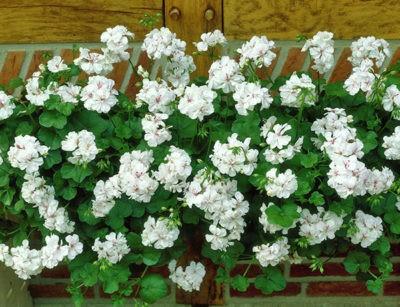

In no case should you spray the plant, since the contact of its leaves with moisture is destructive for them: water can contribute to the appearance of rot.
Top dressing is an important part of caring for pelargonium. Fertilizers should be applied regularly (weekly) during the flowering period (from March to August) of the plant.
Mineral fertilizers of low concentration are best suited. The ratio of two minerals, potassium and nitrogen, with the predominance of the former, should be optimal.
Step by step about the procedure for pruning a plant
For ampelous varieties, pruning is not a mandatory procedure. Nevertheless, to give the plant a decorative look, you can periodically carry it out. The first step is to remove all yellowing, old and withering leaves, as well as weak dry branches.
Diseases, pests and other possible complications
Ivy-leaved pelargonium, with proper care, rarely gets sick, which is why it is so important to timely fertilize the soil, water the plant and monitor the light in the room where it grows.
In some cases Pelargonium can get sick with gray mold or black leg. When gray mold appears, which is a fungus, it is necessary to remove all diseased leaves and treat the plant with some kind of fungicide. At the same time, it is advisable to reduce watering, and ventilate the room well.
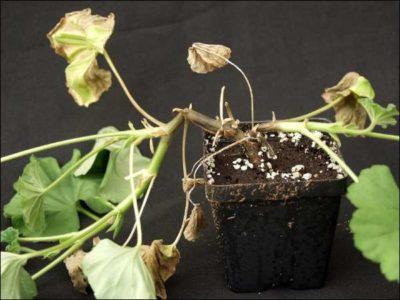

The appearance of a "black leg" (darkening of the stem) is a bad sign. The plant is immediately destroyed. All others should be watered less generously, and the soil must be sterilized before planting geraniums.
Besides diseases, other problems may arise with geraniums:
- The yellowing of the leaves, followed by their fall, indicates a lack of incoming moisture. In this case, it is enough just to increase the amount of water used for irrigation.
- Reddening of the leaves. This situation is typical for a plant that is supercooled. Be sure to check that the temperature in the room where the geranium is growing is appropriate. Also, the pot should not be too cold (which happens when there are drafts in the house).
Why doesn't it bloom?
If the ampelous geranium looks healthy outwardly, but at the same time flowering does not occur in any way, it is safe to say that the temperature regime is above normal: place the plant in a cooler room.
That's all the nuances that you need to know for the successful cultivation of ampelous geraniums at home. Good luck!
If you find an error, please select a piece of text and press Ctrl + Enter.
Pelargonium or geranium is a bright, beautiful flower, loved by many growers for its unpretentious disposition and long flowering. Pelargonium is translated from Greek as "stork", and geranium as "crane", so the plant got its name for the similarity of its inflorescences with the heads of these birds.
Ivy Pelargonium pests
Why do monstera leaves turn yellow - diseases and pests
Pests usually affect plants with weakened immune systems. Common cultural misfortunes:
- aphid. Sucks juices from leaves. The plant dries out gradually.If there are few insects, they can be washed off under the pressure of water or collected by hand;
- whitefly. The female lays many eggs on the leaves, from which midges with white wings quickly emerge. To get rid of insects, the affected leaves are plucked, the plant is sprayed with a drug called aktara;
- spider mite. A thin web is a sign of the appearance of a pest. They get rid of the tick by irrigating the bushes with actellik or phytoverm.
Note! The root system can be damaged by a worm, a nematode. In this case, the bushes are destroyed, since there is no point in fighting pests. Plants can only be saved by propagation by cuttings.
1.Types of ampelous pelargonium
Ampel geranium belongs to hanging gardens, so it is appreciated not only for its beautiful and bright flowers, but also for beautifully hanging shoots. Often, when planting geraniums in hanging pots, they decorate gardens, parks, terraces, open areas and balconies with it.
The ampelous types of geraniums include ampelous ivy or thyroid pelargonium. She comes from South Africa, but due to her unpretentiousness she feels great with us.
The falling branches of ampelous pelargonium can reach 1 meter. Its flowers are simple and double, have a variety of color shades from white to red and resemble pompons, the leaves are dense, smooth, five-fingered, green or variegated in color. Ampelous pelargonium blooms from early spring to late autumn. In addition to the long flowering period, another characteristic feature is its ease of reproduction and maintenance.
Description of the appearance and origin of the name
Ivy geranium owes its name to the specific shape of the leaves, which resemble ivy leaf plates, but are slightly smaller in size. This variety belongs to ampelous, all representatives of which have a common characteristic - flexible branches hanging down.
Houseplants of ivy geraniums are somewhat different from those that grow in natural conditions - the leaf plates of the former are more delicate and thin, and the stems fall in cascades. Unlike other varieties of the plant, ampelous has smooth dark green leaves without felt hairs. The width reaches 5-6 centimeters.
The flowers of the plant are cactus-shaped or star-shapedcollected in umbellate inflorescences. They differ in their small size and a variety of shades.
Reproduction of ampelous pelargonium
Ampel ivy pelargonium can be propagated by seeds and cuttings.
2.1. Reproduction of ampelous pelargonium by seeds
Growing pelargonium from seeds is a complex method that depends on many factors and, above all, on the quality of the seeds themselves. Most often, the reproduction of ivy-leaved pelargonium from seeds is used to obtain a large number of seedlings, which will then be used to decorate flower beds in parks and alleys.
When breeding with seeds, ampelous pelargonium is more demanding. Planting and grooming takes more time and effort. Sowing seeds should be started in winter or early spring, so that by the beginning of summer it is already possible to use mature plants for planting.
The seeds of this type of ampelous pelargonium are rather large and strong. Therefore, to increase germination a few days before planting requires preparation.
- First of all - the seed coat must be thinned... To do this, you can use fine sandpaper or even a nail file. This is necessary in order to slightly cut the surface of the seed shell, but this must be done very carefully so as not to damage the inner seed.
- Then the seeds are needed soak in water room temperature for 24 hours.
- The third stage of preparation - disinfection... The seeds must be placed in a weak solution of potassium permanganate. After that, they must be taken out and dried.
You can take ready-made soil for planting, which is sold in special stores, or you can prepare it yourself.For ampelous pelargonium the soil should consist in equal proportions of peat, sand and turf.
Having prepared the soil mixture, you need it moisturize well and only then can the seeds be placed in it. It is necessary to deepen the seeds by no more than 5 mm. They must be placed on the soil surface at a short distance from each other and lightly sprinkled with earth on top. There is no need to tamp the earth, it must remain loose for better seed germination.
Then the container with seeds must be covered with a transparent material and placed in a warm room, with a maintained temperature of 22 - 24 degrees. At this time, it is necessary to provide good lighting. Under these conditions, the first shoots will appear within 10 days.
After the first full-fledged leaves appear, the seedlings can be transplanted into separate containers. This must be done very carefully, because the roots of the plant are very fragile and can easily be damaged. Plants grown from seed bloom in the first year of planting.
Reproduction of ampelous pelargonium by seeds is a very laborious process, therefore, this method is mainly used by experienced flower growers.
2.2 Reproduction of ampelous pelargonium by cuttings
Novice growers use the method of grafting ampelous pelargonium, which is the simplest.
Propagation by cuttings can be carried out as in the fall, when Pelargonium is pruned for the winter, and in the spring, if the plant has grown well and requires pruning.
Seed reproduction
This breeding method is considered too difficult for beginner growers, it is only suitable for professionals. If you still want to use the seed of the plant, then the best time for this comes in February and lasts until mid-April.
You can plant seedlings both in ordinary light loose soil, and in special peat tablets, but only large ones. Sowing is carried out in pits with depths of up to 10 mm. In this case, the soil should be well moistened, just it can be pre-sprayed with a spray bottle. Then the container with the planted seedlings is turned into an impromptu greenhouse, covered with a transparent film. These pots are placed in a well-lit place, but not in direct sunlight. The first shoots should appear in about a week. And after a month, geraniums can be transplanted into permanent containers.
Note! Not all varieties reproduce well by seed. Many growers advise options such as Tornado. This is a hybrid with red flowers and a shoot length of 30 cm. The Crystal hybrid is also suitable for these purposes. You can grow flowers at home of several varieties at once. Such a set will decorate the most modest summer cottage.
3.Rules of care for ampelous pelargonium ivy at home
Caring for ampelous ivy-leaved pelargonium cannot be called difficult, but it still has some features.
3.1 Lighting
- This type of geranium loves abundant sunlight and tolerates direct sunlight well. Therefore, in apartments, it must be located on the southern windows, and on the street, planted in illuminated places.
3.2 Soil and planting container
- Ampel pelargonium is not very demanding on the composition of the soil. It should be nutritious, loamy and loose enough with good drainage. Pelargonium tolerates dry soil well, but is very afraid of waterlogging, so good drainage is essential. Expanded clay can be used as drainage.
- Pot, in which the pelargonium is planted is also of great importance. It depends on how luxuriant the flower will bloom. The larger the pot in which the plant is planted, the smaller and more magnificent the flowering will be. Therefore, the container must be taken of a small size and when transplanting an adult plant, increase the capacity of the pot by no more than 1.5 - 2 cm than the previous one.
3.3 Watering
- Proper watering - this is the key to abundant flowering and good care of ampelous pelargonium at home. She likes abundant watering, but excessive moisture can be detrimental to the plant. Thus, watering geraniums is necessary only after the topsoil has dried. For good flowering, it is necessary to ensure that the earthy clod does not dry out and the water does not stagnate in the container of the plant. For this, good drainage must be provided. In summer, ampelous pelargonium is watered more often, in winter, watering is reduced to a minimum. It is not necessary to spray with pelargonium, as this can lead to rotting on the leaves. For the full development of pelargonium, ampelous needs fresh air, so it needs constant ventilation, but drafts should be avoided.
3.4 Fertilization
- Caring for ampelous geraniums at home cannot be called complete without plant feeding... It is necessary to feed ivy pelargonium during the period of growth, budding and flowering, that is, from the beginning of spring to the end of summer, the plant requires feeding. Fertilizers need to be applied every 10 -14 days. It is important to know when and what fertilizers should be applied. The quality of flowering directly depends on this. Fertilizers rich in nitrogen stimulate the growth of greenery, so it is advisable to apply them in early spring, when the plant begins to grow. During the budding and flowering period, it is necessary to use fertilizers rich in potassium and phosphorus. They provoke lush flowering. For feeding, you can use ready-made mineral fertilizers for this type of flowers, or you can use homemade ones. For example, a decoction of onion peels or diluted milk. It is also advised to use water with the addition of iodine for irrigating geraniums. To do this, you need to dilute a drop of iodine in 50 grams of water and pour over the edge of the pot. In the autumn-winter period, feeding of ampelous pelargonium is stopped.
3.5 Transplant and pruning of ampelous pelargonium
- Ampelous geranium transplant carried out in the spring and then only when the flower has grown greatly and its roots do not fit into the old pot. Basically, the transplant is carried out once every two years. If the plant is still placed in its old pot, then it is not replanted, but the topsoil is simply replaced.
- Pruning ampelous geranium spend the opposite - in the fall, when the plant is preparing for winter rest. Pruning is needed to rejuvenate the plant and give it a more decorative shape. All bare or elongated shoots are cut off, forming a compact bush. After a while, side shoots will appear and the plant will become thick. Re-pruning of pelargonium is carried out in the spring if it has grown well over the winter. Pruning correctly will create a beautiful plant and achieve lush flowering.
3.6. Caring for ampelous pelargonium ivy in the autumn-winter period
- Proper care of ampelous pelargonium in the autumn-winter period is let the plant rest and do not disturb with unnecessary care. In order for the flower to fall asleep, the room where the flower is located must be cool. Lighting, on the other hand, should be bright and long-lasting. If pelargonium lacks light, its leaves and shoots will become weak and it will not be able to subsequently please with lush greenery and abundant flowering. Therefore, if necessary, it is necessary to provide her with additional lighting. Watering must be reduced, since the land dries out much longer in winter, and fertilization is not needed during this period.
Fulfilling all these simple rules, you can grow ivy ampelous pelargonium at home, and the lush flowering will delight the eye throughout the summer.
How to propagate pelargonium
Seed method
From their numerous reviews on the reproduction of asthenia, it is clear that the seed growing method gives greater resistance to disease, hardening and endurance in the event of drafts or temperature changes.Seeds are sown in February in moist soil, previously disinfected with a solution of potassium permanganate. Small seeds are sprinkled with a thin layer of soil, once again moisten the soil from a spray bottle and cover with a film.
It is necessary to ensure that the condensation does not cause excessive moisture, therefore, the film is slightly opened every day until the moment when shoots appear. The temperature for sprouts in the room should be at least 20 degrees Celsius. After the appearance of real leaves, the plants are moved to a cooler room and grown at +17 degrees. After one and a half or two months, geraniums can be transplanted to a permanent "residence".
Cuttings
This method is used quite often. One clear advantage should be noted here, which is the preservation of all the properties of the parents by the daughter plants, starting with the appearance. This fact is of particular importance for those who are engaged in breeding rare varieties of pelargonium.
Planting material is the tops of vertical shoots with four paired leaves, their length is 8-10 cm. Cutting is best done in February - March, as well as in July-August. It is these periods that are distinguished by the effectiveness and simplicity in plant propagation.
After cutting, the stems need to be treated with coal powder and kept at room temperature for several hours, the cutting sites will dry out slightly during this time. During this time, you can prepare a mixture consisting of peat and sand, moisten it well and plant cuttings in it, deepening them by about 2.5-3 cm.In order to get young seedlings from cuttings, the following conditions must be observed:
- Withstand the temperature of + 20-22 degrees during root germination;
- Moderately moisten the soil so as not to provoke stem rot at ground level.


After about 30 days, the cuttings grow their own roots, and they turn into young independent plants. When the root system is quite strong, pelargonium is transplanted in containers with a diameter of 9-10 cm. In the future, care consists in watering, forming a bush and feeding, that is, in those very points related to caring for adult plants. Young geraniums bloom already this year, as soon as spring comes into its own.

